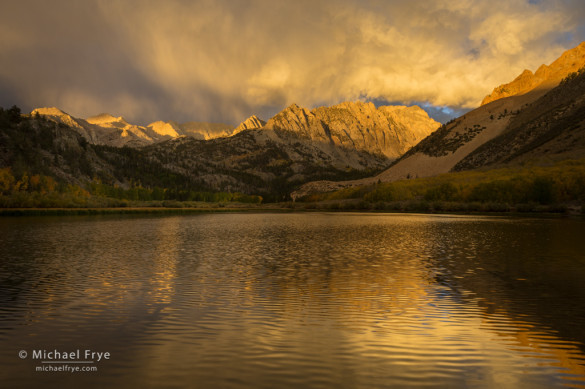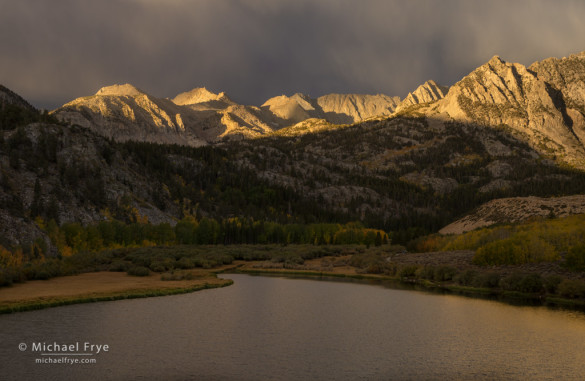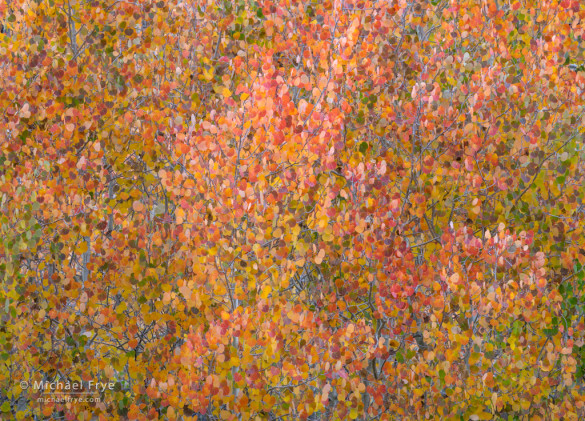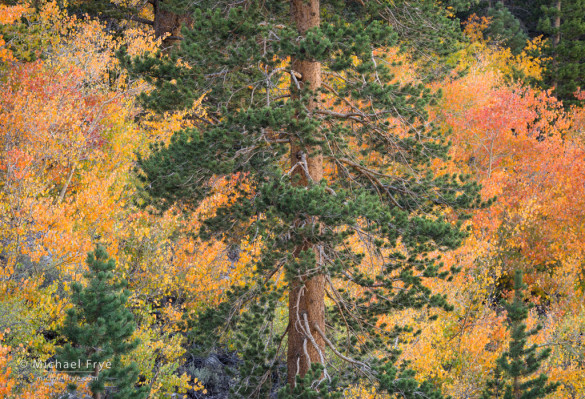After photographing lightning near Bishop on Saturday night (see my previous post), I thought there might be some interesting clouds still hanging around on Sunday morning, so I woke early and drove up to North Lake, near the upper end of Bishop Creek Canyon.
And there were clouds – almost too many. Another small rain squall was moving up from the south along the Sierra crest, approaching Bishop Creek Canyon just as the sun was due to rise. There were enough clouds to the east that I thought they might block the light. And I think some clouds lingering over the White Mountains did block the very first sunlight, but just after sunrise some clouds started to turn color overhead, and soon the peaks began to light up as well.
It evolved quickly into a dramatic scene. It was a little breezy, rippling the water surface, but there were still nice reflections at first. Then the wind increased, so I climbed up the ridge along the eastern shore of the lake to get a different perspective, one that didn’t depend as much on reflections.
Soon the clouds closed in, the light disappeared, and it started sprinkling. Back at the car I ran into my friends Dave and Franka – a nice surprise. It turns out that they had been camping nearby the whole weekend. Then it started raining more seriously, so it seemed like a good time to head back to Bishop.
Early Fall Color
Before our trip to Bishop, I’d been hearing reports of early color on the east side. It was too windy for aspen closeups Sunday morning, but I saw some nice color at North Lake, especially near the outlet creek. Overall I’d say the color was similar to last year, which was also a little early. But there were still lots of green trees, and the peak color in the upper reaches of Bishop Creek Canyon hasn’t arrived yet. Give it another week or so. North Lake is at about 9,000 feet. At Aspendell, just a little lower at 8,500 feet, the aspens were dark green, so they have a way to go.
Monday afternoon Claudia and I drove up Rock Creek Canyon. This road climbs to over 10,000 feet, so you can often find fall color there earlier than anywhere else on the east side of the Sierra. And the very highest aspens in Rock Creek Canyon were at about peak color, with some bare branches, and some green, but most trees quite colorful.
The problem with this area (and with most high-elevation aspens) is that the trees are short and scrubby. You won’t find the nice tall, straight, white trunks that can add so much structure and beauty to aspen photographs. I tried working with the patterns of leaves, and found a couple of compositions I liked, which you’ll find below.
On the drive home we also saw some color on the highest reaches of Parker Bench (south of Parker Lake), and near Warren Canyon in Lee Vining Canyon. These are both high-elevation spots, and it’s not unusual to see some trees turning there this time of year.
Overall I’d say that the color is a little early for the higher-elevation aspens on the east side. Some of these areas, like North Lake and Lake Sabrina, may peak around the end of September, rather than the first week of October. But this doesn’t really mean anything for the mid- and lower-elevation trees. They may turn a little early, or they may turn at their usual times. A lot depends on the weather over the next few of weeks. It’s unusually warm right now, but temperatures are forecast to drop late this week, with a chance for a dusting of snow Saturday above 9,000 feet. Then temperatures are expected to warm up again next week. That colder spell this weekend is likely to start some mid-elevation trees turning, but may not have much effect on the lower-elevation aspens. If the colder weather brings wind, that will strip most of the early-turning, high-elevation trees of their leaves. We’ll see.
Mid-elevation aspens include the ones in lower Bishop Creek Canyon, upper Lundy Canyon, Conway Summit, and Dunderberg. Lower-elevation aspens include the ones around Convict Lake, lower McGee Creek, June Lake Loop, Lee Vining Canyon, and lower Lundy Canyon (in other words, most of my favorite aspen-photography locations). The mid-elevation trees typically turn around the first or second week of October, while the lower elevation ones are usually best around the third week of October.
I’ll let you know what I see and hear during the coming weeks, but I can’t be everywhere, so if you head over to the east side and see some fall color, please post a comment and let us know what you find. Also, here are some additional resources to help you keep up with the latest fall-color developments:
- Natural History Wanderings, Sandy Steinman’s blog.
- Calphoto, a Yahoo discussion group with reports from photographers around California.
- California Fall Color—with the caveat that when they say “Go Now!” they’re usually jumping the gun, and you should probably wait a week. Check the accompanying photos (which often show lots of green trees even when they say “Go Now!”).
- Parcher’s Resort gives good information about the Bishop Creek area.
It’s such a great time of year for photography, and it’s just getting started!
— Michael Frye
Related Posts: A Stormy Night; Signs of Autumn
Did you like this article? Click here to subscribe to this blog and get every new post delivered right to your inbox!
Michael Frye is a professional photographer specializing in landscapes and nature. He is the author or principal photographer of The Photographer’s Guide to Yosemite, Yosemite Meditations, Yosemite Meditations for Women, and Digital Landscape Photography: In the Footsteps of Ansel Adams and the Great Masters. He has also written three eBooks: Light & Land: Landscapes in the Digital Darkroom, Exposure for Outdoor Photography, and Landscapes in Lightroom 5: The Essential Step-by-Step Guide. Michael written numerous magazine articles on the art and technique of photography, and his images have been published in over thirty countries around the world. Michael has lived either in or near Yosemite National Park since 1983, currently residing just outside the park in Mariposa, California.













Thank you Michael for your report. Very nice pictures indeed.
mARTin
You’re welcome Martin, and thanks!
Thanks for the detailed report, Michael. I’ll be on the eastern side of the Sierras with some photographer friends for a week starting this Sunday, so it’s really great to benefit from your intimate knowledge of the area and the timing of fall color.
You’re welcome Greg!
The first photo of the leaves looks like a mosaic. It’s beautiful!
Thank you Bev!
Thanks for the Fall Foliage report Michael, and I have to admit, I did “Go Now” when I read the words on the California Fall Color Blog. 3 hours down and 3 hours back. In one day. Beautiful stormy skies all day Sunday, but the fall colors at Virginia Lake, Conway Summit, and up into Mammoth Lakes just weren’t there. Sigh… And thank you for explaining that the beautiful tall aspens are at the lower elevations. I think I’ll take your advice and “Go the third week in October”. I did make it back to Lake Tahoe in time to shoot the smoky sunset, but looking back, I should have stayed home.
You’re welcome Dotty. Sorry you didn’t find the color you were looking for; the third week of October is a good bet for areas around Lee Vining, but if things look like they’re turning earlier I’ll report something here.
Love the kaleidoscope one! It reminds me my favorite – “aspens with a dusting of snow” from Conway Summit.
Thank you Bart!
I agree, all good stuff, but the kaleidoscope is exceptional!
Thank you Fabrizio!
We drove up the 395 several days ago, but the smoke was really obscuring the peaks – couldn’t even see the Whitney group… =:o( Has it cleared?
That must have been Friday, when there was smoke blowing down from the King Fire. The wind changed the next day.
If you would add my name to your list I would love to see more of your work. I lived in Bishop for many years, but now live over the mountain. Thank you for your beautiful photography.
Thanks Elaine! Since my email list provider requires a confirmation from you, it’s actually easier if you subscribe yourself. You can do this near the top of this page on the right side, where it says “Subscribe by Email.”
Thanks, will do.
Thanks for the update and images, Michael – what a great sunrise! I dayhiked McGee Creek on Sunday the 21st, and though there were a few nice patches of color, it had quite a ways to go, probably another ten days.
Thanks for the report Jackson!
This is an incredible shot!My husband is the real photographer in the family. I paint watercolors. We are headed for Yosemite and want to photograph the total lunar eclipse on the wee hours of October 8, maybe from the Glacier Point area as the valley walls are too high to get any great shot of the sky. We were able to get some awesome shots last year in October during the first snowstorm of the season but are humbled by what I see on your blog. You are an incredible photographer! We are SO sorry to miss your next workshop. My husband would love it! I will be on the lookout for the next opportunity!
Thanks very much Mama! I wouldn’t suggest going to Glacier Point for the eclipse, as the moon will be to the west, and the view from Glacier Point is to the east. I’ve written a number of times on this blog about PhotoPills and The Photographer’s Ephemeris, which are both great tools for figuring out where the moon will be in relation to the landscape.
Thanks so much. I just sent you an email. We were considering Glacier Point. Won’t do that!
Michael, thanks for sharing these updates. Regarding other foliage developments on the east side, I was in the Laurel Canyon / Laurel Lakes area last weekend (the weekend of the 20th). There was some really nice color up through the canyon. In some spots the color was pretty well along, maybe even past peak, but in other areas it was almost all green, so there was quite a mix. But of course that road requires a vehicle with fairly high clearance and careful driving to avoid hitting the rocks. Here’s an example of what it looked like last weekend: https://flic.kr/p/pq38HV
Thanks for the report Bill. Just in case anyone reading this wants to try the same journey, I’d say the road to Laurel Lakes requires real high clearance (not a Subaru), and unless you’re a very experienced driver, low-range 4WD.
These photos are so interesting and lovely! This time, however, it was your detailed, written narrative that brought forth memories from long ago when I did a backpack trip from North Lake to South Lake and experienced some of the most spectacular and beautiful high Sierra, ever!
To this day, I still remember my gasp when we crested the trail and got our first look at Evolution Valley. And, I have never seen another alpine lake that matches the emerald color of Evolution Lake. Wish I could find those filmed photos. I can only imagine what digital photography could capture today…
Thanks Ann! And I’m glad this post brought back good memories for you. I’ve never been to Evolution Valley, but it’s definitely on my list.
Hi Michael, Thanks for this update!
I’m planning to go to Lee Vining some time in October, mainly to do Lee Vining Canyon, Lundy Lake and June Lake Loop. Do you think the weekend of Oct 10/11 is better, or Oct 17/18?
Hope to see you again soon!
Best,
Matthias
You’re welcome Matthias. As I said, the areas you mention are usually best around the third week of October, so in a typical year the 17th and 18th would be better. It’s too early to know whether this will be a typical year in those spots, but at this point that’s what I’d go with.
Great – Thanks, Michael!
Hi Michael!
So glad I found you and am subscribed to your blog! Enjoyed this post in your blog and can’t wait to get into look into your books and future posts! Please tell me on the photo above…
Jeffery pine with autum aspens, did you do some kind of paint effect? Curuious beacuse it looks like a beautiful painting.
Thank you for sharing your talent and knowledge!
Dena
Thank Dena – I’m glad you found me! No, I didn’t use any “paint effect” on that photo.